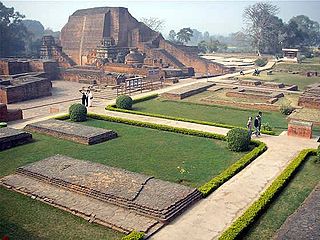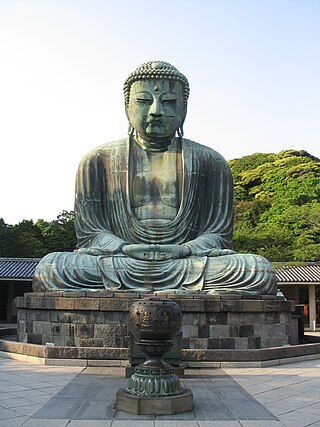Related Research Articles

Buddhist philosophy is the ancient Indian philosophical system that developed within the religio-philosophical tradition of Buddhism. It comprises all the philosophical investigations and systems of rational inquiry that developed among various schools of Buddhism in ancient India following the parinirvāṇa of Gautama Buddha, as well as the further developments which followed the spread of Buddhism throughout Asia.

In Buddhism, the Four Noble Truths are "the truths of the Noble Ones", the truths or realities for the "spiritually worthy ones". The truths are:

The Noble Eightfold Path or Eight Right Paths is an early summary of the path of Buddhist practices leading to liberation from samsara, the painful cycle of rebirth, in the form of nirvana.
Pāramitā or pāramī is a Buddhist term often translated as "perfection". It is described in Buddhist commentaries as a noble character quality generally associated with enlightened beings. Pāramī and pāramitā are both terms in Pali but Pali literature makes greater reference to pāramī, while Mahayana texts generally use the Sanskrit pāramitā.

The five precepts or five rules of training is the most important system of morality for Buddhist lay people. They constitute the basic code of ethics to be respected by lay followers of Buddhism. The precepts are commitments to abstain from killing living beings, stealing, sexual misconduct, lying and intoxication. Within the Buddhist doctrine, they are meant to develop mind and character to make progress on the path to enlightenment. They are sometimes referred to as the Śrāvakayāna precepts in the Mahāyāna tradition, contrasting them with the bodhisattva precepts. The five precepts form the basis of several parts of Buddhist doctrine, both lay and monastic. With regard to their fundamental role in Buddhist ethics, they have been compared with the Ten Commandments in Abrahamic religions or the ethical codes of Confucianism. The precepts have been connected with utilitarianist, deontological and virtue approaches to ethics, though by 2017, such categorization by western terminology had mostly been abandoned by scholars. The precepts have been compared with human rights because of their universal nature, and some scholars argue they can complement the concept of human rights.
Theravāda is the most commonly accepted name of Buddhism's oldest existing school. The school's adherents, termed Theravādins, have preserved their version of Gautama Buddha's teaching or dhamma in the Pāli Canon for over two millennia.
Ethics involves systematizing, defending, and recommending concepts of right and wrong behavior. A central aspect of ethics is "the good life", the life worth living or life that is simply satisfying, which is held by many philosophers to be more important than traditional moral conduct.

The Dīgha Nikāya is a Buddhist scriptures collection, the first of the five Nikāyas, or collections, in the Sutta Piṭaka, which is one of the "three baskets" that compose the Pali Tipiṭaka of Theravada Buddhism. Some of the most commonly referenced suttas from the Digha Nikaya include the Mahāparinibbāṇa Sutta, which describes the final days and passing of the Buddha, the Sigālovāda Sutta in which the Buddha discusses ethics and practices for lay followers, and the Samaññaphala Sutta and Brahmajāla Sutta which describe and compare the point of view of the Buddha and other ascetics in India about the universe and time ; and the Poṭṭhapāda Sutta, which describes the benefits and practice of Samatha meditation.

Upāsaka (masculine) or Upāsikā (feminine) are from the Sanskrit and Pāli words for "attendant". This is the title of followers of Buddhism who are not monks, nuns, or novice monastics in a Buddhist order, and who undertake certain vows. In modern times they have a connotation of dedicated piety that is best suggested by terms such as "lay devotee" or "devout lay follower".

Buddhism, also known as Buddha Dharma and Dharmavinaya, is an Indian religion and philosophical tradition based on teachings attributed to the Buddha, a wandering teacher who lived in the 6th or 5th century BCE. It is the world's fourth-largest religion, with over 520 million followers, known as Buddhists, who comprise seven percent of the global population. Buddhism originated in the eastern Gangetic plain as a śramaṇa–movement in the 5th century BCE, and gradually spread throughout much of Asia. It has subsequently played a major role in Asian culture and spirituality, eventually spreading to the West beginning in the 20th century.

Buddhist ethics are traditionally based on the enlightened perspective of the Buddha. In Buddhism, ethics or morality are understood by the term śīla or sīla (Pāli). Śīla is one of three sections of the Noble Eightfold Path. It is a code of conduct that emulates a natural inborn nature that embraces a commitment to harmony, equanimity, and self-regulation, primarily motivated by nonviolence or freedom from causing harm It has been variously described as virtue, moral discipline uprightness and precept, skillful conduct.

Saṃsāra in Buddhism and Hinduism is the beginningless cycle of repeated birth, mundane existence and dying again. Samsara is considered to be dukkha, suffering, and in general unsatisfactory and painful, perpetuated by desire and avidya (ignorance), and the resulting karma.
In Buddhism, the eight precepts is a list of precepts that are observed by lay Buddhists on observance days and festivals. They include general precepts such as refraining from killing, but also more specific ones, such as abstaining from cosmetics and entertainments. This tradition of keeping the eight precepts on observance days are still widely practice in all Theravadin Buddhist countries and Theravadin Buddhist communities worldwide. Based on pre-Buddhist sāmaṇa practices, the eight precepts are often upheld on the Buddhist observance days, and in such context called the uposatha vows or one-day precepts. They are considered to support meditation practice, and are often observed when staying in monasteries and temples. In some periods and places the precepts were widely observed, such as in 7th–10th-century China by government officials. In modern times, there have been revival movements and important political figures that have observed them continuously.

The Dighajanu Sutta, also known as the Byagghapajja Sutta or Vyagghapajja Sutta, is part of the Anguttara Nikaya. For Theravadin scholars, this discourse of the Pāli Canon is one of several considered key to understanding Buddhist lay ethics. In this discourse, the Buddha instructs a householder named Dīghajāṇu Vyagghapajja, a Koliyan householder, on eight personality traits or conditions that lead to happiness and well-being in this and future lives.
The following outline is provided as an overview of and topical guide to ethics.
Damien Keown is a British academic, bioethicist, and authority on Buddhist bioethics. He is Professor Emeritus in the Department of History at Goldsmiths, University of London. Keown earned a B.A. in religious studies from the University of Lancaster in 1977 and a Ph.D. from the Faculty of Oriental Studies at the University of Oxford in 1986.
In contrast with many Indian religious traditions, Buddhism does not regard the body and the mind or spirit as being two entirely separate entities - there is no sense in Buddhism that the body is a "vessel" that is guided or inhabited by the mind or spirit. Rather, the body and mind combine and interact in a complex way to constitute an individual. Buddhist attitudes towards the body itself are complex, combining the distaste for sensual pleasure that characterizes the general Buddhist view towards desire with a recognition of both the individuals dependence on the body, and the utility of the body as an aide in the development of insight. Issues of gender, the mortification of the body, and the body as a source of troublesome desire are all addressed within the Buddhist scriptural tradition directly, while Buddhist attitudes towards other, more contemporary issues have continued to develop and change in response to the social and material changes in modern society.
Ethics is the branch of philosophy that examines right and wrong moral behavior, moral concepts and moral language. Ethics or moral philosophy is a branch of philosophy that "involves systematizing, defending, and recommending concepts of right and wrong behavior". The field of ethics, along with aesthetics, concerns matters of value, and thus comprises the branch of philosophy called axiology.

The three poisons in the Mahayana tradition or the three unwholesome roots, in the Theravada tradition are a Buddhist term that refers to the three root kleshas that lead to all negative states. These three states are delusion, also known as ignorance; greed or sensual attachment; and hatred or aversion. These three poisons are considered to be three afflictions or character flaws that are innate in beings and the root of craving, and so causing suffering and rebirth.
Buddhist thought and Western philosophy include several parallels.
References
- ↑ This is a contestable point. The reason that the "mid-1990s" is stated is due to the sharp increase in activity in the field at that time: the publication of the first systematic study of the topic, the founding of the first academic journal devoted to the topic, and an American Academy of Religion panel (Philadelphia, 20 November 1995) devoted to "Revisioning Buddhist Ethics". Before this short span, there were ventures into Buddhist ethics, but no period marks such a dramatic "burst" in academic activity as the mid-1990s.
- ↑ Keown, Damien (1992). The Nature of Buddhist Ethics, p. 1.
- ↑ (1979 Vol. 7 (1) pp.1-64)
- ↑ Keown, Damien (1992). The Nature of Buddhist Ethics, p. 1.
- ↑ Buddhist Ethics as Virtue Ethics
- ↑ Keown, Damien (24 June 1992). "Chapter 8: Buddhism and Aristotle". The Nature of Buddhist Ethics. Palgrave Macmillan. pp. 193–227. doi:10.1007/978-1-349-22092-2_8.
- ↑ Buddhist Ethics in Western Context: The Virtues Approach Archived 20 February 2009 at the Wayback Machine
- ↑ Siderits, "Buddhist Reductionism..." p.293
- ↑ At the same time elsewhere Pearce cites the 14th Dalai Lama at the Society for Neuroscience Annual Meeting 2015, who said: “If it was possible to become free of negative emotions by a riskless implementation of an electrode - without impairing intelligence and the critical mind - I would be the first patient." (Pearce, David (1 May 2009). "A World Without Suffering?". The Hedonistic Imperative. Archived from the original on 22 January 2022. Retrieved 28 March 2022.) (Chatterjee, Anjan; Farah, Martha J., eds. (2013). Neuroethics in Practice. Oxford University Press. p. 245. ISBN 9780195389784.)
- ↑ Pearce, David. "Buddhism and the Conquest of Suffering". BLTC Research. Archived from the original on 7 March 2022. Retrieved 28 March 2022.
- ↑ Pearce, David (2017). "Life in the Far North". In Vinding, Magnus (ed.). Can Biotechnology Abolish Suffering?. North Carolina: The Neuroethics Foundation.
- ↑ "THE WAY TO SOCIAL HARMONY / Pyinya.HTM". Archived from the original on 17 May 2008. Retrieved 6 November 2008.
- ↑ "Sigalovada Sutta: The Discourse to Sigala".